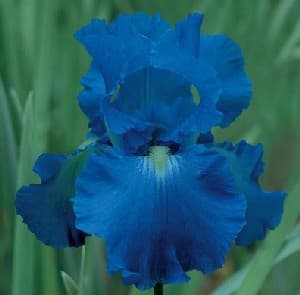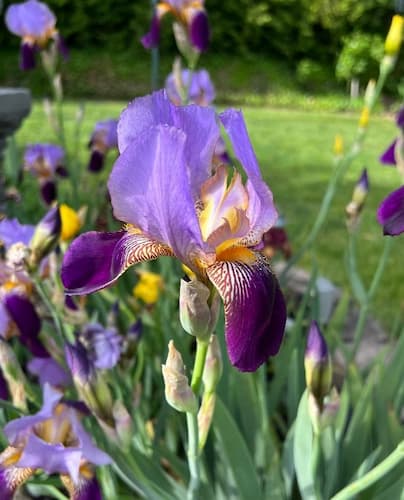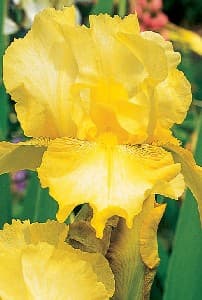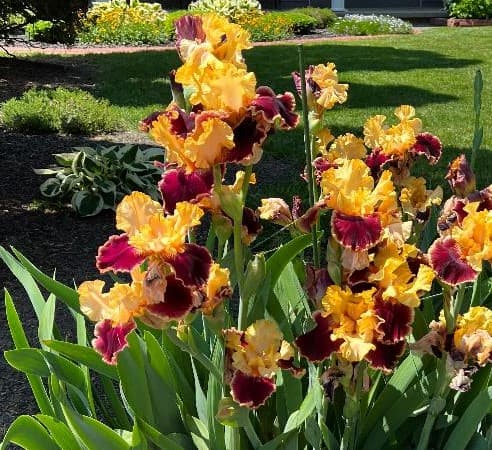How to Grow Iris

About Growing Iris in Your Home Flower Garden
With a couple of hundred varieties in several different colors and combinations, Iris Flowers are popular and easy to grow perennial. The varieties of Iris plants are grouped according to rhizome versus bulb types. The most common larger varieties are great at the back of the flower bed. They make great cuttings. For flower growers, there is a place in your garden for one or several groups. But, be careful, as they spread quickly and can overcome other flowers.
They are good in flower beds and around rock gardens. Many of us have deer roaming around the neighborhood. Deer do not like the taste. And, it is a poisonous plant that they will avoid.
Irises make great cut flowers, with their tall, sturdy stalks.
Did You Know? The Iris flower represents royalty and power.
Iris Plant Specifications
Flower Colors: Shades of blue, lavender, orange, purple, yellow, white, and even brown. Additionally, there are many bi-colors.
Flowers Bloom: Late spring to early summer, depending upon variety.
Plant height: Most varieties grow 1 to 3 feet tall. Dwarf varieties grow much smaller, less than eight inches tall.
Light Requirements: Six to eight hours or more of full sunlight.
Ideal Soil pH: 5.5 – 6.5.
Toxic?: Yes. They are harmful to humans and pets.
Deer Resistant?: Yes. Deer do not like the taste. And, it is poisonous to them too.
Hardiness Zones: 3 – 9
Number of Species: 310
Botanical Name: Iridaceae
Plant Type: Perennial

Are Iris Plants Edible?
NO!!
All parts of the Iris plant are poisonous to humans and pets. And, it is a serious poison for cattle and other farm animals.
Consumption can result i a variety of illnesses, some of which are quite serious. If you have young children, you may want to grow another non-toxic bloomer.
Medicinal Uses for Iris Plants
Despite its toxicity, Iris roots have been used for medicinal purposes since ancient times. Among the medical uses are:
- It treats skin problems.
- Use it to treat a variety of stomach problems.
- It is a treatment for syphilis.
Caution: As previously mentioned, all parts of Iris plants are poisonous. We strongly recommend you do not make a home remedy yourself from this plant unless you are trained to do so by a qualified professional.
Light Requirements
Sunlight is essential to producing beautiful spring blooms. To produce the best, most colorful blooms, plant Irises in a location where they will receive full sun. They need a minimum of six to eight hours of bright, direct sunlight to properly bloom. They will grow in partial shade, but the quality of the blooms will be affected. With too little sunlight, they will not bloom at all.
Varieties of Irises
There are 250 – 300 varieties of these easy-to-grow perennial Iris flowers. Regular Irises come in several colors. Bearded Iris is very popular. There are many beardless Iris flowers as well.
Some varieties are grown from Rhizomes. Other varieties are grown from bulbs.
Iris Plant Propagation
Depending upon the variety, perennial Iris plants are grown from bulbs, seeds, and root separation. The roots, or Rhizomes, are easily separated and replanted. The Rhizome looks like a long, thin potato with roots underneath. When transplanting, separate the Rhizome. Make sure to have some root and a leaf or two in each section. Plant the Rhizomes near the surface with the roots below. Space them a foot or so apart. They will fill in the spaces quickly.
For bulb varieties, plant bulbs are three inches deep.
While the flowers produce weeds, it takes much longer for the plant to mature and to produce flowers. So, most gardeners propagate them using rhizomes of bulbs.

How to Grow Iris Flower Plants
If you want low-maintenance and easy-to-grow flowers, you have come to the right plant. Irises like full sun but tolerate partial shade well. Their only demand is well-draining soil to avoid root rot. The soil does not need to be the richest in your yard. Nor, does it demand heavy fertilizer feeding.
Mulching around the plants will help to keep out the weeds. Once established, you will need to water them only in the driest part of the year. Fertilize occasionally. Do not apply heavy doses of Nitrogen.
When planting, make sure to put it in a spot where it can grow and thrive for years. It will spread quickly and will need to be thinned or divided regularly. To divide them, simply pull up some of the Rhizomes. The remaining plants will reward you with healthier plants and bigger blooms. As for what to do with the Rhizomes you have culled from your garden….give them to friends!
Also see: Plant Problems – Identify the causes and find the cures.

Pruning Iris Plants
Your plants will thrive with little or no pruning. On occasion, there is a sick or damaged leave. Remove it to improve the plant’s attractiveness.
After the flowers have died back, cut off the flower stalk at the base. Do not cut the plant down at this point. The leaves continue to send energy back to the Rhizomes for next year’s blooms.
However, if you want to experiment with growing them from seeds, do not cut the spent flower. Instead, allow the seed pods to develop. Then, remove the pods after they have turned brown and dried. We recommend you perform a Seed Germination Test sometime during the winter. It is a fun gardening project.
Growing Irises in Containers
Irises are not the best choice to grow in containers or flowerpots on your patio or deck. But, some people do grow them in this manner. Like other container plants, they require a little extra attention than when planted in the ground.
- Use flowerpots or containers with drain holes in the bottom. This allows excess water to drain so the roots will not rot.
- Keep an eye on the moisture level. Check the plants every day or two, especially in extended periods of hot, dry weather. Keep the soil moist, but not wet. It is okay to let the top of the soil begin to dry between watering. When watering the plants, thoroughly wet the soil. Excess water will drain through the hole in the bottom of the flowerpot.
- Nutrients in a flowerpot are limited. So, use fertilizer spikes to feed the plants. Or, apply a light solution of liquid fertilizer every 3 – 4 weeks.
- It is important to bring them indoors during the winter months.
- In areas with a mild winter, store the flowerpot in a shed, garage, or greenhouse. In colder regions, put them in a garage where the temperature does not down well below freezing for long periods of time.
Insects and Plant Disease
Being a hardy plant, Irises are not often bothered by insects. They can suffer from occasional root borers.
Irises seldom are affected by disease. The most common problem is root rot, which is caused by poorly draining soils. In preparing beds, make sure soil is light and well draining. Raise the soil level if need be. Also add sand, and compost if you have clay soil.
Overwintering Perennial Iris Plants
The plant’s rhizomes are relatively hardy. After the plant dies off, cut it down at ground level. Then in colder regions, apply a layer of mulch to protect them. However, you do not have to do this in most areas.
Related Articles
Also, people who read this article will like:
Please support our site. Shop for:
- rmmatthews100@hotmail.com
- 585-721-6528
- Rochester, NY
©1999-2024 GardenersNet.Com, All Rights Reserved

